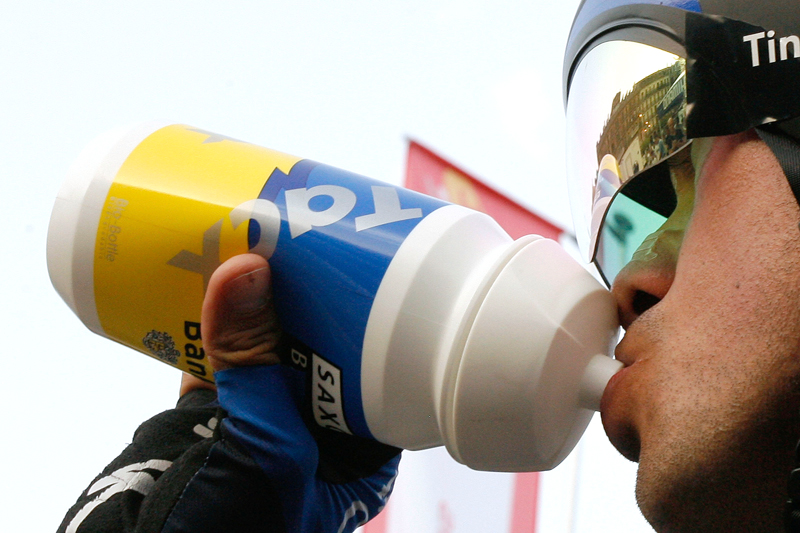Fueling on the move: bar wars

Solid, gel or liquid? Sports Performance Bulletin investigates how the choice of carbohydrate format affects performance...
As your training volume increases, so does the need to consider fueling. That’s because athletes who train most days of the week for durations of an hour or more may end up running down their stores of muscle glycogen, which is your body’s premium fuel during hard exercise. This is true even when a high-carbohydrate diet is consumed. Since only small amounts of muscle glycogen depletion can lead to fatigue with a sensation of ‘heavy limbs’ and poor performance, avoiding muscle glycogen depletion is definitely a good nutritional strategy!Fueling on the move
One way to help reduce muscle glycogen depletion during periods of high-volume training is to consume carbohydrate on the move. Consuming carbohydrate during exercise provides muscles with carbohydrate for energy, which means less is needed from the breakdown of muscle glycogen. Not only does this prolong endurance at the time, it also helps prevent gradual depletion of muscle glycogen when training takes place over several consecutive days.Of all the sports supplements out there, carbohydrate supplements in the form of drinks, gels and bars have rightly received the most attention from sports scientists. That’s because literally hundreds of studies have shown that consuming 60-80 grams per hour of rapidly-absorbed carbohydrate during exercise can help delay the onset of fatigue and significantly improve endurance performance, especially in events over two hours’ duration, or when performing consecutive days of hard training.
More recently, scientists have sought to optimize carbohydrate formulations and feeding recommendations. This research gave rise to the so-called ‘two to one’ carbohydrate products, which provide two parts of glucose to one part of fructose for faster absorption and greater uptake by working muscles. But while these hi-tech formulations have become very popular in drinks, gels and bars, some researchers have wondered if we’ve overlooked something very basic – the format of the carbohydrate. In other words, regardless of the formulation, does the way it’s delivered affect its effectiveness? Put simply, are you better off consuming your ‘in-exercise’ carbs as drinks, gels or bars?
Giving it the beans
You might think that providing the actual carbohydrate type is the same, it shouldn’t matter too much if there’s lots of water present (ie carbohydrate drink), a small amount present (gels) or very little present (bars). Surprisingly however, there’s actually been relatively little research into this topic. In a study published twelve years ago, researchers did look at this issue by comparing the effects on endurance performance of giving cyclists either carbohydrate drinks, gels, sports beans (like jelly beans) or water(1).On four separate days, 16 male and female cyclists rode at 75% of their VO2max (moderate intensity) for 80 minutes followed by a 10km flat-out time trial. In three of the four trials, they consumed 0.6 grams per kilo of bodyweight per hour of carbohydrate. However, the form of the carbohydrate was varied in each trial; one trial used carbohydrate drink, one trial used gels, one trial used solid sports beans. In the fourth trial, they consumed plain water – this was used as the control trial.
The results showed that compared to water, the 10km time trial times were significantly faster when the beans, carbohydrate drink or gels were used (see figure 1). Moreover, there was no real performance difference between the beans, carb drink or gels – all produced a time that was around half a minute faster than drinking plain water (although the solid beans just about produced the fastest times).
Figure 1: 10km time-trial times

Bar blues
You might conclude from the above that so long as you consume the right kind of carbs, it doesn’t really matter what form that carbohydrate is in. However, these athletes above were consuming around 40-50 grams of carbohydrate per hour rather than the optimum 60-80 grams per hour. What happens when you try and supplement carbohydrate a higher rate? In a more recent study, scientists tried to answer this question by looking at well-trained cyclists consuming carbohydrate drinks, gels and bars (or indeed, a combination of products) during intense exercise(2).Twelve 12 male cyclists completed four separate trials on four occasions in a random order. Each comprised a 140-minute race simulation, followed by a ramp test to exhaustion (where the workload was increased by 10 watts every 30 seconds). During the trials, the cyclists were fed 80 grams per hour of a two-to-one carbohydrate formulation (a formulation known to be easy on the tummy and rapidly absorbed). However, in each of the trials, the format given was varied as follows:
- Trial A – carbohydrate drinks
- Trial B – carbohydrate gels
- Trial C – carbohydrate bars
- Trial D – a mix of the above
Gels or drinks?
So assuming bars are the least preferable option for supplementing high levels of carbohydrate, what should you use – drinks or gels? While some studies have looked at carbohydrate supplementation taken in the form of gels, very few have looked at how gels compare to carbohydrate drinks in terms of user-friendliness. However, a 2009 study looked at the gastrointestinal (GI) tolerance of high-carbohydrate intakes using gels during intense running in 34 endurance runners(3). The researchers found that, regardless of whether the runners consumed a pure glucose or glucose/fructose gel formulation, the average scores for GI symptoms were at the low end of the scale, indicating ‘predominantly good tolerance’. However, they also pointed out that around 10-20% of the runners experienced serious gastric upset, and that for these runners, feeding strategies using drinks might be required.This ties in with research from 2016 on the running performance of triathletes using carbohydrate energy drinks or gels(4). This showed that the triathletes’ performances were the same regardless of which energy product they used. However, when it came to comfort, 7 out of the 9 triathletes reported gastrointestinal discomfort (tummy cramps, bloating etc) when using gels. In contrast, not one of the triathletes experience tummy problems when consuming the carbohydrate drink. One possible explanation as to why a carbohydrate drink could be preferable is that it provides a constant concentration of carbohydrate when consumed. Consuming gels (or bars) plus water however could result in different (and at times higher) carbohydrate concentrations, depending on the timing of water consumption.
Train your tummy
Before making final recommendations, it’s worth mentioning another study, which suggests that whatever type of carbohydrate supplementation you decide to use, you need to use it consistently in training before trying it in an important event! In this study, 25 endurance runners performed a ‘gut-challenge trial’ comprising of 2 hours of running at 60% VO2max (easy pace) whilst consuming gel discs containing 30 grams carbohydrates in the form of 2:1 glucose-fructose, every 20 minutes (90 grams per hour – a lot!)(5). Following this, the runners were then split into three groups, which differed only in what the runners were allowed to consume during the running training:- Gel discs
- Solid carbohydrate food
- Placebo (no carbs)
Practical advice
What do these findings mean for fueling on the move? Here are some practical recommendations that will help you get the best out of whichever carbohydrate you eat or drink during training and competition:Bars: During intense bouts of exercise or when you need maximum energy intake, solid carbohydrate such as bars might be quite hard on the tummy, and hamper your performance. Thinking about it, this is perhaps not that surprising; apart from the fact that the carbohydrate in bars is solid and much harder to disperse into the stomach, many bars also contain significant amounts of fat, which can delay gastric emptying, increasing the risk of gastric distress.
*PP verdict: Probably best used during longer, less intense bouts of exercise when you crave something more substantial. Even then, bars may be less suitable for consumption when running, where gastric problems are more likely to occur (compared to say, cycling). Choose a bar with a low fat content (under 10%).
Gels and drinks: Most evidence suggests that gels and drinks are pretty equal in terms of the performance benefits they bring. However, while there may be no performance differences between drinks and gels, drinks could be the better option for athletes with sensitive tummies.
*PP verdict: During harder workouts or races, or when your intake of carbohydrate is high (above 60 grams per hour) stick to drinks and gels rather than using energy bars or other solids. When using gels however, don’t forget to consume extra plain water, especially in warm conditions. If you have a very sensitive tummy, drinks may be slightly better tolerated at high carbohydrate intakes.
Formulation: When consuming high intakes of carbohydrate (best done as gels or drinks), choose a 2:1 glucose/fructose formulation. Studies clearly show that at these high intakes, 2:1 formulations are absorbed more rapidly and cause less gastric distress than glucose-only formulations.
Familiarity: Whatever carbohydrate you decide to use in competition, make sure your body is familiar and happy with it beforehand – ie use it extensively in training first! NEVER try something new in a race situation. If you’re unused to ingesting carbohydrate at high intake levels, try doing so during training in the run up to a race as the evidence suggests this could help improve your gut tolerance, making it easier to do so on the big day.
References
- Int J Sport Nutr Exerc Metab. 2008 Apr;18(2):179-90
- Int J Sport Nutr Exerc Metab. 2016 Dec 20:1-21. doi: 10.1123/ijsnem.2016-0211
- Int J Sport Nutr Exerc Metab. 2009 Oct;19(5):485-503
- Int J Sport Nutr Exerc Metab. 2016 Apr;26(2):114-22
- Appl Physiol Nutr Metab. 2017 May;42(5):547-557
You need to be logged in to continue reading.
Please register for limited access or take a 30-day risk-free trial of Sports Performance Bulletin to experience the full benefits of a subscription. TAKE A RISK-FREE TRIAL
TAKE A RISK-FREE TRIAL
Newsletter Sign Up
Testimonials
Dr. Alexandra Fandetti-Robin, Back & Body Chiropractic
Elspeth Cowell MSCh DpodM SRCh HCPC reg
William Hunter, Nuffield Health
Newsletter Sign Up
Coaches Testimonials
Dr. Alexandra Fandetti-Robin, Back & Body Chiropractic
Elspeth Cowell MSCh DpodM SRCh HCPC reg
William Hunter, Nuffield Health
Keep up with latest sports science research and apply it to maximize performance
Today you have the chance to join a group of athletes, and sports coaches/trainers who all have something special in common...
They use the latest research to improve performance for themselves and their clients - both athletes and sports teams - with help from global specialists in the fields of sports science, sports medicine and sports psychology.
They do this by reading Sports Performance Bulletin, an easy-to-digest but serious-minded journal dedicated to high performance sports. SPB offers a wealth of information and insight into the latest research, in an easily-accessible and understood format, along with a wealth of practical recommendations.
*includes 3 coaching manuals
Get Inspired
All the latest techniques and approaches
Sports Performance Bulletin helps dedicated endurance athletes improve their performance. Sense-checking the latest sports science research, and sourcing evidence and case studies to support findings, Sports Performance Bulletin turns proven insights into easily digestible practical advice. Supporting athletes, coaches and professionals who wish to ensure their guidance and programmes are kept right up to date and based on credible science.









